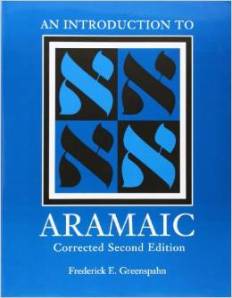Greenspahn, Frederick E. An Introduction to Aramaic: Corrected Second Edition. Society of Biblical Literature, 2003.
 Nota bene: Greenspahn’s work is probably the first academic attempt at a functional (as opposed to reference) grammar for Biblical Aramaic. As such, it can be appreciated for the advances that it makes, but the present author also recognizes some areas where improvements can be made.
Nota bene: Greenspahn’s work is probably the first academic attempt at a functional (as opposed to reference) grammar for Biblical Aramaic. As such, it can be appreciated for the advances that it makes, but the present author also recognizes some areas where improvements can be made.
Strengths
- Assumes prior knowledge of Biblical Hebrew… but the present author believes it is advantageous to be proficient in Hebrew before moving on to Aramaic.
- Exercises work both Aramaic-to-English and English-to-Aramaic so that students are learning at a deeper level than just recognition value.
- Exercises primarily drawn from the Biblical and para-Biblical texts for inductive learning.
- Inclusion of not only the Aramaic portions of the Tanakh, but also of the B’rit Chadasha (NT).
- Inclusion of some extra-Biblical Aramaic, e.g. Elephantine Papyri, DSS, Bar Kokhba Letters, and Targum Pseudo-Yonatan.
- Excellent introductory matter covering the history of the language (in brief).
Weaknesses
- Passages from Daniel and Ezra included in the exercises are stripped of some of their helpful grouping tropes and pausal markers.
- The inclusion of the answer key in the textbook itself could be a handicap and temptation for academic dishonesty. Separating this out would be preferable.
- Lacking in some of its explanations, leaving the reader with questions that direct him or her to a reference grammar (e.g. Rosenthal or Johns) for answers.
- For all it includes, this grammar neglects the Eastern Peshitta, which is of the same general style of Aramaic as the Daniel and Ezra portions which comprise the bulk of the focus and is available in Asshuri block script.
- Still numerous typographical errors for a volume entitled “Corrected” Edition.

Leave a comment